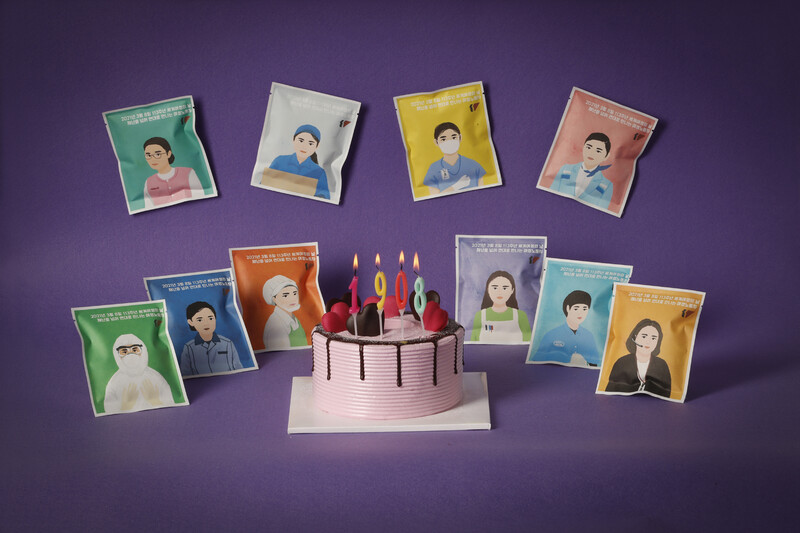Jeong-soon, who was cleaning Asiana in-flight, and Gye-wol, who used to use LG Tower, were also unemployed.
Where is the workplace that guarantees the right to live and human rights?

Female’transparent workers’ who were easy to erase from our daily life, such as carers, cleaning workers, and customer service consultants, were brought back to life as portraits. This work was completed by illustrator Hee-Rok Jang with the Women’s Committee of the National Federation of Democratic Trade Unions ahead of World Women’s Day this year. The sincere gaze of staring at the front contains the dignity of female workers who open the future with solidarity. The committee conspired with the stories of women workers and presented a limited edition coffee bag with this portrait to the selected. On March 8, 1908, 113 years after female workers in the United States raised the lanterns of women’s rights at Rutgers Square in New York, shouting “Bread and Roses”. The journey toward a world without gender discrimination will continue. With these women who are invisible but clearly present. By Lee Jung-ah, staff reporter [email protected]

The shock of the Corona 19 pandemic was not at all equal. The substance of the new normal (the new standard) is not visible, but socio-economic inequality has grown more than before Corona 19, and the solution has become more complex. Six years ago, Kim Jeong-soon (65), who had been’going home’ on the first train of Line 5 from 7-2 of Sinjeong Station on the Seoul subway line, met Kim Gye-wol (59), who was’going to work’. When I found out that way, the two women workers who had been saying hello for six years in the morning have not been able to meet on the subway since last spring. Gyewol worked for Asiana Keio (KO). It is a subcontractor in charge of in-flight cleaning of Asiana Airlines. The impact of Corona 19 was great. The company demanded unpaid leave indefinitely and fired six workers who refused. Gyewol was one of them. Jeong Soon, who was waiting for Gyewol, can’t get on the first car anymore. He was a worker at a service company cleaning the LG Twin Tower in Yeouido, Seoul. This is because the company lost his job in November of last year due to the unilateral termination of the contract of the LG affiliate, the original contractor. The employment crisis is a survival crisis. Even in the employment crisis, there is a gender gap, which has been widening since Corona 19. Immediately after the first spread of Corona 19 (March 2020), when the number of female workers decreased by 115,000 compared to the same month last year, the number of male employed decreased by 81,000. The second spread (September 2020) decreased by 283,000 women (109,000 men), and the third spread (December 2020) decreased by 357,000 women (271,000 men). The number of employed women in their 50s like Kim Gye-Wol increased by 110,000 to 130,000 each year, but decreased by 76,000 last year. The number of women employed in their 30s, which increased by 10,000 to 20,000 per year, also decreased by 77,000 last year. As the number of employed women in their 30s and 50s, which supported the female employment rate, declined, the number of female employees turned to a decline for the first time in 11 years since 2009.
Last month, the Women’s New Work Center (Saeil Center) of the Ministry of Gender Equality and Family surveyed 1,100 female workers about the difficulties they face after the spread of Corona 19. Most of those who cited the gap in caring for children (33%) due to school closures and closures. Even before Corona 19, female workers had a higher ratio of working and caring than male workers. Concerns about caring vacancy push women out of work, lock them in their homes, and lead to career breaks. The number of women on temporary leave who were pushed out of work reached 499,000 last year. Compared to 2019, it has more than doubled. The increase is not stopping. In January, when Corona 19 re-proliferated, the number of women on temporary leave increased by 154,000 from the same month last year. The Korea Economic Research Institute said that if one temporary leave increases, the number of employed will decrease by 0.35 next month. The 8th is Women’s Day. On March 8, 1908, American women workers protested, “Give us bread and roses.” Bread means the right to live, and the rose means the basic right. Kang Kyung-hee, a second-year labor manager, applied for the stories of Kim Gye-Wol and Kim Jeong-soon to the Noh Hoe-Chan Foundation, which is delivering roses to women workers in celebration of Women’s Day every year following the will of the late Rep. Two women workers, who had been working unnoticed, went out to the streets to find their own bread and roses. Women workers, who are no longer transparent, demand a workplace where the right to live and human rights are guaranteed. By Lee Jeong-yeon, staff reporter
